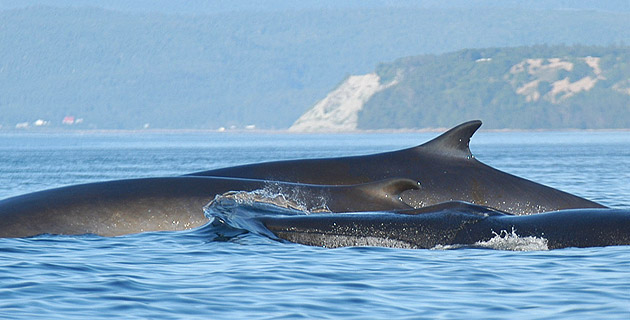Fin whales may not be the largest of the whales, but they are certainly one of the fastest! This advantage long allowed them to escape the whaler’s harpoon, at least until the 20th century when whaling gear became mechanized. No longer able to outrace their pursuers, the global fin whale population drastically dropped until an international moratorium was established. According to Fisheries and Oceans Canada, between 1903 and 1945, as many as 13,000 fin whales were killed in Canada’s Atlantic waters.
Fortunately, the decline of fin whales is not irreversible. Conservationists are keeping their eyes on the global fin whale population: for three generations, the number of individuals has been on the rise! The latest estimates from the International Union for the Conservation of Nature (IUCN) even suggest that the population may be recovering.
This increase in the number of fin whales on the planet is changing the status of the species. According to the IUCN Red List, fin whales are now considered “vulnerable”, a status of less concern than before. In Canada, the status of the species in the Atlantic is still considered of concern by the Committee on the Status of Endangered Wildlife in Canada (COSEWIC) and the Species at Risk Act.
“Overall, even if the conditions for fin whales have improved and the animals are becoming more numerous, this is not the case for all populations. Some populations are still at risk,” points out Christian Ramp. “Especially whales in coastal environments such as the ones venturing into the waters of the St. Lawrence, as they have to deal with an increased human presence compared to those that remain offshore.”
Situation in the St. Lawrence
Of the plentiful North Atlantic fin whales, only a few visit the Gulf of St. Lawrence and its Estuary to feed between May and November. The Mingan Island Cetacean Study (MICS) team estimated their number at 328 between 2004 and 2010. From 2010 to 2016, surveys indicate that the same population probably numbered fewer than 300 individuals.
The downward trend in fin whale sightings in the St. Lawrence is also accompanied by a decrease in observations of mother-calf pairs. MICS research coordinator Christian Ramp notes that: “Before 2010, we used to observe between 5 and 20 calves swimming with their mothers every year. Unfortunately, in recent years, we haven’t been seeing more than two per year. Some years there aren’t even any!” GREMM scientific director Robert Michaud adds: “We do not know whether this decrease reflects lower reproduction rates or if it is the result of a change in distribution that might have led to fewer females coming to the St. Lawrence with their calves.”
Sparse data
The decline in the number of fin whales in the St. Lawrence indicates that something in the ecosystem is out of sync. “Unfortunately, we are not able to identify the source of the problem or determine its extent,” adds Christian Ramp.
Unlike the right whale carcasses that grab all the headlines, fin whales do not necessarily float to the surface. Because most of them sink, they are much less accessible for researchers trying to pinpoint the causes of population decline. Fin whale mortalities may be attributable to multiple factors, including noise pollution, coastal industrial development, ship strikes and entanglement in fishing gear.
This uncertainty with regard to the threats faced by fin whales is also felt at IUCN. Data are still lacking to confirm the estimated number of individuals in the oceans and to be able to affirm, without a doubt, that fin whales are out of danger.






